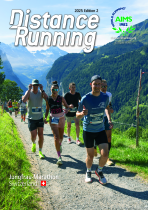Features
01 January 2005, 8am UTC
Beauty and the beast
When marathon legend Dick Beardsley traveled to the north-eastern corner of the USA, to run the Mount Desert Island Marathon, he found out what more than a thousand other runners have discovered in the marathon’s three-year life.
It’s a beast of a course, but it’s run in one of the most beautiful areas imaginable. “It’s absolutely gorgeous, but it’s definitely a tough course,” said Beardsley. “It’s just a first-class event.”
This was just the sort of response race architect and director Gary Allen had in mind when he first dreamt of a marathon on his home island. He was bored by the trend towards flat, featureless marathons designed to boost runners’ times. He saw the marathon as a test of mettle, and wanted to create a race that would return to the roots of running.
Allen knew that if he took care of the organization, nature would take care of the rest. Located about three-quarters of the way up the coast of the state of Maine, Mount Desert Island’s rocky coast and mountain vistas have attracted visitors from around the world for generations. Home to Acadia National Park, the island brims with opportunities for the outdoor enthusiast, from hiking and biking to sea kayaking. There are also ample opportunities to shop in the hundreds of local island retailers.
The island’s stark beauty attracts three million visitors each year and the marathon provides a unique way of appreciating it. Winding through three towns and half a dozen villages on quiet rural roads, runners enjoy spectacular views. Somes Sound, the only fjord on the Atlantic Coast, and Northeast Harbor, with its magnificent shingle-style cottages, are just two of the highlights.
The race is held at a time when the New England fall foliage is at its brightest, and when runners can count on nearly ideal temperatures (typically between 10-15ºC) and brilliant sunshine. With all this, it is no wonder that Eco Marathon voted the course the most scenic in the United States.
But nature held a few surprises this year. Race day dawned to a window rattling, nerve wracking and very violent thunderstorm. The race hotel was hit by lightning which showed the proximity of the storm. The sound of sharply cracking thunder and streaking lightning kept the field at bay until the last possible minute.
The start line remained empty as runners huddled in doorways and sought shelter where they could find it, but 10 minutes before the 08.00 start the skies cleared and the race was on.
The starting gun was fired by Gary Allen, sporting a black bowler hat and a vintage tuxedo tail coat with “Mount Desert Island Marathon” embroidered on the back in hot pink lettering. The race was as spectacular as his attire. Runners first encountered the Tarn, a small glacial pond, and the picturesque valley passing close by Dorr Mountain. The hills were alive with vibrant reds, oranges and yellows of the peak fall foliage season.
At 10km runners turn onto Cooksey Drive, passing summer cottages first built by prominent Americans such as Edsel Ford and the Rockefeller families, to reach the calm waters of Seal Harbor. The marathon route provides ocean vistas, quiet woodlands, steep granite cliffs, quaint village centers, pristine lakes and Somes Sound.
Over the first two editions volunteer numbers have almost equaled the runners and they were again out in their hundreds. Along Main Street in the village of Northeast Harbor, welcome banners stretched over the marathon route. Runners reach Somes Fjord at 14-17 miles. With cliffs on the right, deep blue water on the left and a winding road ahead, runners are inspired by the beauty of their surroundings. Then comes another beast of a hill, at mile 19. This is “Granite Hill” named for the famous quarries which produced Maine granite for cathedrals and cobblestone streets still seen in New York and Boston.
At Mile 20 runners reach Somesville, the first permanent settlement on Mount Desert Island, founded in 1761. The signature white clapboard homes and churches, along with the white wooden curved bridge over the tranquil village mill pond makes runners feel as if they are part of a postcard. Then come soothing views of Echo Lake and the Western Mountains casting their shadows on the waters in the late morning light, before runners toil towards the highest point of the course at mile 24.
The race captures the essence of the small-town communities that dot Mount Desert Island. With less than 20,000 year-round residents in four towns, the island is home to a vibrant running community that knows how to treat guests, and especially guest runners. Aid stations are ample, but runners marvel at the number of offers for water and support they receive as they pass homes and spectators along the route. Runners finish on Main Street in Southwest Harbor, a traditional fishing community of approximately 2,000. The street is shut down to traffic, allowing the hundreds of fans who gather there the chance to urge runners over the final yards.
“The course was hard as hell,” said Simon Isaacs, a college runner but first time marathoner. “At 24 miles my legs felt like concrete.” Almost without fail, runners say they were hoping for a race that offered a beautiful course and none have been disappointed. “It was a nice course,” agreed David Herr, from the neighboring state of Vermont, and winner of the first two races. “That’s really what I look for in a race.”
Word has spread quickly, and registration has grown in each of the past two years. The race draws a mixture of runners from across the nation and the globe. First timers come looking to cut their teeth and qualify for Boston. Veteran distance runners come in search of a new challenge. Next year’s race, to be held on 16 October, already looks like it will reach its 1000-runner limit.





